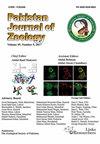Uncovering the Role of Ribosomal Protein L8 in Milk Fat Synthesis Mechanisms in Yak Mammary Epithelial Cells
IF 0.5
4区 生物学
Q4 ZOOLOGY
引用次数: 0
Abstract
, RPL8, mTORC1, SREBP1 The fat content in yak milk is higher than that in dairy cows, but the molecular mechanisms responsible for milk fat synthesis in yaks are still unclear. This study examined the regulatory mechanism of milk fat synthesis in yak mammary epithelial cells (YMECs) by investigating the role of Ribosomal protein L8 (RPL8) in the mTORC1-SREBP1 signaling pathways. The results showed that over-expression or inhibition of RPL8 had a significant effect on triglyceride (TG) secretion, which also affected the sterol regulatory element-binding protein 1 (SREBP1) pathway. Similarly, the intervention of SREBP1 revealed that RPL8 promoted TG secretion through the SREBP1 pathway. Additionally, the study found that over-expression or inhibition of RPL8 regulated the signaling activity of the mammalian target of rapamycin complex 1 (mTORC1), which promoted the SREBP1 signaling pathway through mTORC1. Further examination by over-expressing or inhibiting SREBP1 or mTOR showed that mTOR promoted TG secretion through the mTORC1-SREBP1 signaling pathway. Moreover, YMECs treated with palmitic acid showed increased expression of RPL8, mTOR, and SREBP1, as well as increased TG secretion. Overall, the study’s findings provide insights into the underlying mechanisms of milk fat synthesis in yaks, and suggest that the RPL8 gene and mTORC1-SREBP1 signaling pathways could serve as potential genetic markers for milk fat synthesis in yak mammary glands.揭示核糖体蛋白L8在牦牛乳腺上皮细胞乳脂合成机制中的作用
本文章由计算机程序翻译,如有差异,请以英文原文为准。
求助全文
约1分钟内获得全文
求助全文
来源期刊

Pakistan Journal of Zoology
生物-动物学
CiteScore
1.10
自引率
16.70%
发文量
306
审稿时长
4.5 months
期刊介绍:
Pakistan Journal of Zoology (Pakistan J. Zool.) publishes original articles in English on all aspects of animal life. Generally these articles will be in, or related to one of the following subject areas: Physiology, Cell Biology, Molecular Biology, Genetics, Bioinformatics, Toxicology, Forensic Science, Developmental Biology, Entomology, Parasitology, Microbiology, Biotechnology, Pathology, Palaeontology. Taxonomy, Environmental Biology, Wildlife, Fisheries, Vertebrate and Invertebrate Morphology. Additionally, the journal considers research on health and clinical studies. Short communications are regularly considered, however, uninvited review articles, first records/reports of known species, case reports/studies and survey reports are not published in Pakistan Journal of Zoology.
 求助内容:
求助内容: 应助结果提醒方式:
应助结果提醒方式:


